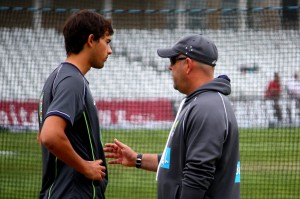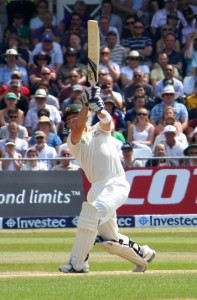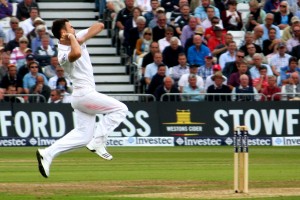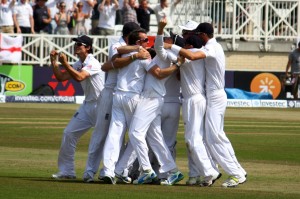Archive for the ‘james anderson’ Category
Monday, July 15th, 2013
Boy oh boy. Have we had some cricket these last five days.
From the surprise selection of 19-year-old left-arm spinner Ashton Agar on Wednesday morning, to an England victory by 14 runs – echoes of Edgbaston 2005 – there have been riches aplenty for those of us for whom all those endless previews were starting to meld together into one amorphous mass of reheated churnalistic chip-wrap.
A number eleven breaking batting records that have stood since the Golden Age of Trumper and Armstrong; a thick edge that somehow goes unsighted by a respected umpire and the howls of controversy that followed; a side written off even before landing on these shores refusing to roll over and die, and it’s fair to say none of the previews led us to expect anything like this.
I was fortunate to be at Trent Bridge on the first and last days: on the way to the ground on Sunday we passed the Australian team bus, complete with Boof-Shrek doll stuck to its windscreen, and we saw them bowled out via the decision review system and the thinnest of thin edges as 17,000 fans held their breath in the broiling heat before erupting in relief and celebration – or despair, if you were one of the many travelling Aussie fans who’d helped ensure a five-day sellout. It was magnificent. It was crazy. It was exhausting, as Haddin and Pattinson chewed away the total required while the crowd chewed down its fingernails. It occurred to me, after everything that had happened the previous four days, that cricket should occupy its own temporal frame of reference, the way one human year equates to seven dog years, or the time it takes Jupiter in terms of Earth days to accomplish a circuit around the sun.
I kind of had an inkling it would go this way, watching the Australians warming up on the outfield before the start of play. Despite (or perhaps because of) the highlights of Day Four playing on the big screen behind them, Darren Lehmann made sure to keep his charges’ attention focused and their spirits high, organising a team huddle, taking the lead in a boisterous kickabout, larking about and playing the clown, but also having a quiet word with individual players, most notably Ashton Agar, who received the benefit of Boof’s wisdom during a break in the high jinks. They looked calm, relaxed, and united as a team, with genuine fondness and respect for their new coach. They did not look like a side who thought they were beaten.
 Agar and Lehmann before start of play Whatever Lehmann said to Agar, it worked, as, promoted to number eight, he continued where he’d left off after that fairy-tale knock of 98 that gave Australia a new hero to wake up to along with its Friday morning cornflakes. (That day, Agar’s emergence as a fully formed Test cricketer, was also the day of Ricky Ponting’s 169*, for Surrey at the Oval, in his last ever first class innings – one in, one out.)
Agar provided his partner at the other end, Brad Haddin, with able support in a 43-run, 24.4-over, partnership that soaked up the deliveries sent down by a bowling attack that had already spent a long day in the field and with an old ball that was doing nothing. Such was the epic nature of this match it was easy to view these two through the lens of heroic archetype, the stuff that myth is made of: battled-hardened veteran and youthful recruit, master and apprentice, Pat Garrett and Billy the Kid before that whole betrayal and manhunt thing.
 Brad Haddin – so near and yet so far The ability of the human body to withstand the rigours of extreme exertion while coupled with the will to win can produce greatness. That greatness manifested in Jimmy Anderson, steaming in from the Radcliffe Road end with a new ball that had all four remaining batsmen’s names written on it. Agar’s was the first wicket of the day to fall, Haddin’s the last – after a lunchbreak in which Australia were nine wickets down with 20 needed to win. Food may have been the last thing on the minds of the two teams during those 40 minutes. By 2:30 it was all over. Anderson, with 5-73, and ten wickets in the match, looked so exhausted at the Man of the Match presentation afterwards, he could barely string two words together.
It would take a book, and considerably more bandwidth, to describe all the extraordinary things that happened in this Test match. Along with Agar’s sparkling debut, Peter Siddle again proved he is the heart as well as the backbone of Australia’s attack with his fourth Ashes five-for on Day One as England collapsed after winning the toss. Ian Bell’s match- and career-defining innings of 109 came when England desperately needed it; a true-grit ton from a man often criticised for scoring soft runs when someone else has already done the hard graft. Last but not least, there was James Anderson’s unplayable delivery to Michael Clarke on the first day, and his wrecking-ball spell on the last.
 Man on a mission – Anderson steams in And then there was the decision review system, or more specifically, its shortcomings. In reality, it was more human error than failure of technology that caused the controversies, and while the referral by England that saw the back of Haddin and the end of the match was called controversial by some, in that instance it did exactly what it was supposed to – provide clear evidence, using the technology available, to overturn a wrong decision. True, there will be many “what-ifs” as a result of missed deflections, replays that showed evidence contrary to the decision given, and simple umpiring error; but what-ifs, of one variety or another, are what make all matches that linger long in the memory.
If Stuart Broad had walked after edging Ashton Agar to slip, England likely would have lost. If Agar, on 6, had been given out stumped England probably would have wrapped this up on Saturday.
Instead it came down to this: a morning session extended by half an hour, and then, on the restart, the simple equation of one wicket, twenty runs and a tail-end partnership that nearly made the difference.
Some of the previews for Trent Bridge were a little too dismissive of Australia’s appetite for this fight. I’m guessing the previews for Lord’s will make for slightly racier reading.
 England celebrate
Friday, December 3rd, 2010
God knows Jimmy Anderson has known pain at Adelaide.
Four years ago, he was pasted all round the ground.
Since then he earned the reputation of someone who either bowled like Jesus or who sent down the rankest kind of ungodly, wayward filth imaginable. For the England fan, trying to predict which Jimmy would turn up on any given day proved a short-cut to distraction.
The talk before this series was that he would be cannon fodder on decks conducive to batting.
Today, he not only earned himself some karmic compensation for Brisbane, but he also proved that the callow youth, the unfinished, undisciplined article – whose only wicket here in ‘06 was Glenn McGrath’s and who took only five wickets in the entire series at 82.60 – has been banished forever.
It was a fair assumption to make (and one based on bitter experience) that the team batting first would put big runs on the board. No one could possibly have imagined that by the end of the first day, Australia would be blown away for 245, with Anderson the man who not only lit the fuse in his explosive first two overs, but who would lead the other England bowlers in a merry war dance around the burning wreckage.
It was a team effort, this; Broad, Swann and Finn chipping in and backed up by superb ground fielding, and Jonathan Trott setting the tone early on with his dead-eyed throwing down of the stumps to run out Simon Katich off only the fourth ball of the day.
But it was Anderson who was the day’s undisputed star. David Saker, England’s bowling coach, has impressed upon his charges the importance of line and length when conditions are unhelpful. Aim for the stumps. Bowl full. Execute the basics. Give the bastards nothing. Anderson showed today that in this he has been a willing and attentive pupil.
Katich dispatched back to the pavilion, Ricky Ponting came to the crease on the back of a fluent 51 in the 4th innings at Brisbane. He lasted only one ball, playing forward to a beauty of an outswinging delivery that found the edge and ended up in the hands of a jubilant Graeme Swann at second slip.
Michael Clarke was Anderson’s second victim, gone for only 2 to a ball that straightened and came back in. Struggling with woeful form and a back injury, he averages 17.81 in 17 innings at number four, and he must surely now come under extreme scrutiny. Hilditch and co. could do worse than picking someone like David Hussey as a replacement while Clarke takes time out of the international game to get himself right.
Australia failed today because they came up against a bowler who is not only nigh-on unplayable when the ball is swinging, but who is now pretty damned good at the basic stuff as well. The batting was a tale of individual failures, and starts squandered and thrown away. Only Mike Hussey and Brad Haddin succeeded in keeping the wreckage afloat long enough to avoid complete capitulation.
England’s batsmen must now repay the efforts of their bowlers and set the kind of total they must have dreaded from their opponents when Andrew Strauss lost the toss.
Day 2 will be the big push. It will be the day that could determine this series. This will remain a good batting wicket, but they will be facing a fired up Doug Bollinger and Ryan Harris, who, though bowling with a chronic knee injury, sent the last ball of the day down at 94mph.
If this series has so far taught us anything, it is that deviations from the expected order of things can and will occur. England have the upper hand, but only graft and application will put this game beyond Australia’s reach.
Saturday, November 27th, 2010
It’s done.
Michael Hussey and Brad Haddin weathered a superb spell of bowling from England early on to build a partnership that broke records and has made victory for England nigh on impossible.
Hussey, a new man after suffering a prolonged slump in form and a let-off first ball when he edged just short of second slip on Day 2, brought up his ton with a celebration that was more primal scream than war-cry. He has admitted the criticism of recent days has affected him; the decision of the selectors to include both him and Peter Siddle in the side ahead of Dougie Bollinger and a younger batsman now looks to be vindicated.
Hussey’s day was not – again – without its share of luck. Given out lbw on 82 off the bowling of Jimmy Anderson, the decision was overturned on referral when Hawkeye showed the ball pitching outside leg stump. Three runs later Anderson went up again, to no avail: had England not used up both their referrals, the simulation would this time have showed the ball hitting the stumps.
James Anderson’s figures do not accurately reflect how well he bowled today, for no reward. Brad Haddin, who together with Hussey compiled a partnership of 307 that lasted six and a half hours, admitted that the spell he faced from Anderson early in the day was “probably the hardest Test bowling I’ve ever had to face”.
Misfields and dropped catches in the deep added to England’s gloom, and when at last the partnership was broken and the tail-enders mopped up by Finn, Australia’s lead was 221.
England’s innings did not start auspiciously, Strauss rapped on the pads leaving the first ball he faced and having to endure a nervous couple of minutes as the not-out decision was reviewed and upheld due to height.
He and Alastair Cook survived to stumps but a draw is now the best England can hope for. It is a task that that will require cool heads, calm nerves, and some big names to step up. Realistically England will need to bat all of Day 4 and until lunch on Day 5 if they are to escape the Gabbatoir alive.
It was never going to be easy for England at this ground, but they can still come out of this Test with their morale intact if they prove to themselves and their opposition that they have the stomach for this fight, even if defeat now seems the most likely outcome.
Friday, November 26th, 2010
There are two ways you can approach what could be your last Test match, if your form is in the toilet, your best days are behind you, and you are only in the team by the skin of your teeth and by way of a last-gasp 100 in a Sheffield Shield match.
You can grit your way through it, blocking and nudging, barricading yourself into your crease, crawling slowly towards some semblance of a respectable total while knowing that it is only a matter of time before there will be a ball with your name on it and it will be unplayable.
Or you can say fuck all that, and take the bastards on.
Mike Hussey had some luck, first ball he faced. In fact, he had a lot of luck. Steven Finn, fired up after removing Simon Katich with a sharp caught and bowled taken only inches above the ground – not a bad effort for a bloke who’s 6ft 8 – induced an edge from the nervy left-hander which fell just short of Graeme Swann at second slip.
Hussey himself admits he said a small prayer as he nicked it. It is on moments like this that careers are curtailed, or second chances given.
After that – especially against the bowling of Swann – he played like the last couple of years had never happened. Spurning the very concept of timorous defence as though it were completely beneath him, short deliveries were pulled with an imperious efficiency and his footwork and timing were impeccable as he set about righting an Australian ship that was listing at 100-3 when he came to the crease.
By the time bad light had stopped play, two more wickets had fallen – a woefully out of nick Michael Clarke who is likely suffering with his degenerative disc problem more than his team are letting on, and Marcus North, another under-pressure batsman who got a ball from Swann that was simply too good for him. But, with an able wing-man in Brad Haddin, Hussey is proving to be his side’s backbone.
Resuming on 220-5, Hussey and Haddin will face the new ball and an England who just have the edge in the bowling department in a morning session that could decide the outcome of this Test match.
After struggling on the morning of Day 2 to find their line and length, the England seamers recalibrated their radars during the lunch break and came out firing. Finn’s high action and ability to extract bounce as well as his athletic fielding off his own bowling are signs of an exciting young talent, and Jimmy Anderson’s economy was excellent.
Graeme Swann got some tonk – the Gabba is not a happy hunting ground for off-spinners – but given cracks are starting to appear in the wicket he will come into his own in the fourth innings.
For now, all of England’s focus will be on this partnership of Hussey and Haddin, which must be broken quickly if the visitors are to move into ascendancy.
Monday, October 18th, 2010
Shane Warne has a complete hatred of them, the ECB seem to think they’re a brilliant idea, and I suspect I’m not the only one who can’t see the bloody point of them.
I’m talking about the boot camps the England team are now customarily sent on prior to the Ashes. In 2009 it was strategy and tactics meetings preceded by a trip to Flanders Field.
This year, it was rock-climbing, sleeping in tents, abseiling off cliffs, and a visit to Dachau concentration camp.
It’s like company paintball, but with added genocide.
The most immediate, and potentially most damaging consequence, as far as England’s Ashes hopes go, is that during this “bonding exercise”, Jimmy Anderson suffered a cracked rib in a boxing session with Chris Tremlett. Quite what the leader of England’s bowling attack was doing in the ring with 6ft 7 in, potential Ashes-lineup hopeful Tremlett, is anyone’s guess. I’d love to know who thought this was a good idea.
The ECB have assured us Jimmy should be fit in time for Brisbane. But let’s be honest, if he’d broken a bone while boxing in his own time, the wrath of the ECB would have fallen with considerable weight upon him and the poor bastard would never have heard the end of it. It’s for the same reason that it’s not uncommon for people who drive a Formula 1 car or ride a MotoGP bike to have a clause in their contract that forbids them from skiing off mountains and the like.
As far as the visit to Dachau goes: I can appreciate the intent behind it, to open up the eyes of cricketers to a wider world and wider issues beyond their own immediate, cocooned existence.
But there’s something about a bunch of sportsmen visiting the site where thousands of people died as a “team bonding” exercise that makes me feel a little uncomfortable. While the combat element of sport is normal, healthy, and exhilarating – it is what makes victory all the sweeter – there’s a far cry between that and facing a World War One sniper or death in an extermination camp. It is not literally a war our boys are going into, and it is extremely unlikely that anyone will die.
True, this is not the first time cricket teams have visited war sites – Gallipoli has been a popular destination for Australian teams en route to England, but the fact it is now tied in with the cod-science arse-whackery of sports psychology with all its attendant bullshit terms of “insight” “leadership” and “making difficult decisions under pressure” is what makes it a bit fucking much.
So the next time England’s security guru Reg Dickason is burning up his keyboard googling “human disaster areas” in preparation for the next Ashes “boot camp” he’d be better off following Warne’s advice of locking everyone up in the boozer and letting them get on with it.
At the very least, Jimmy Anderson’s ribs will thank him.
|
|



